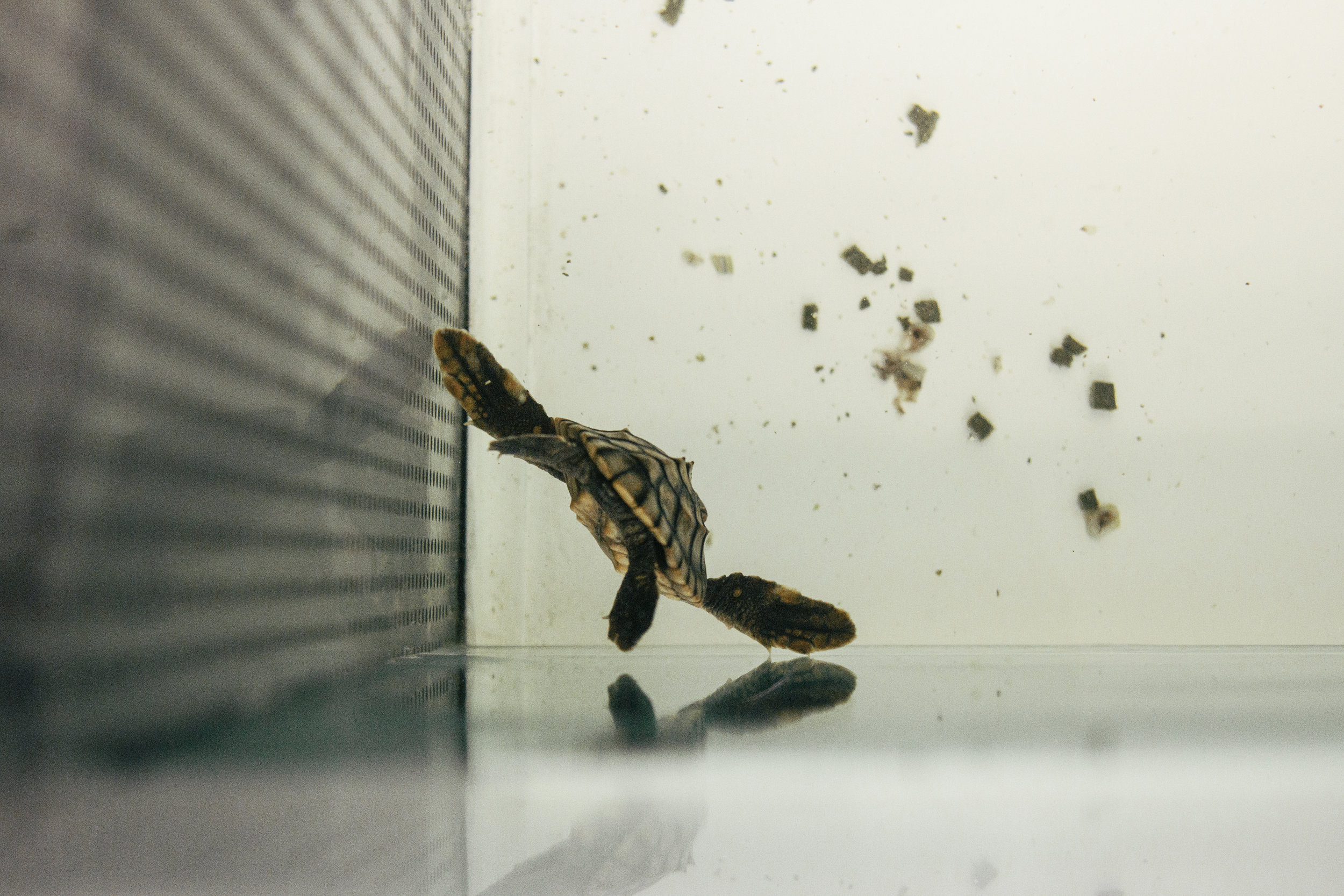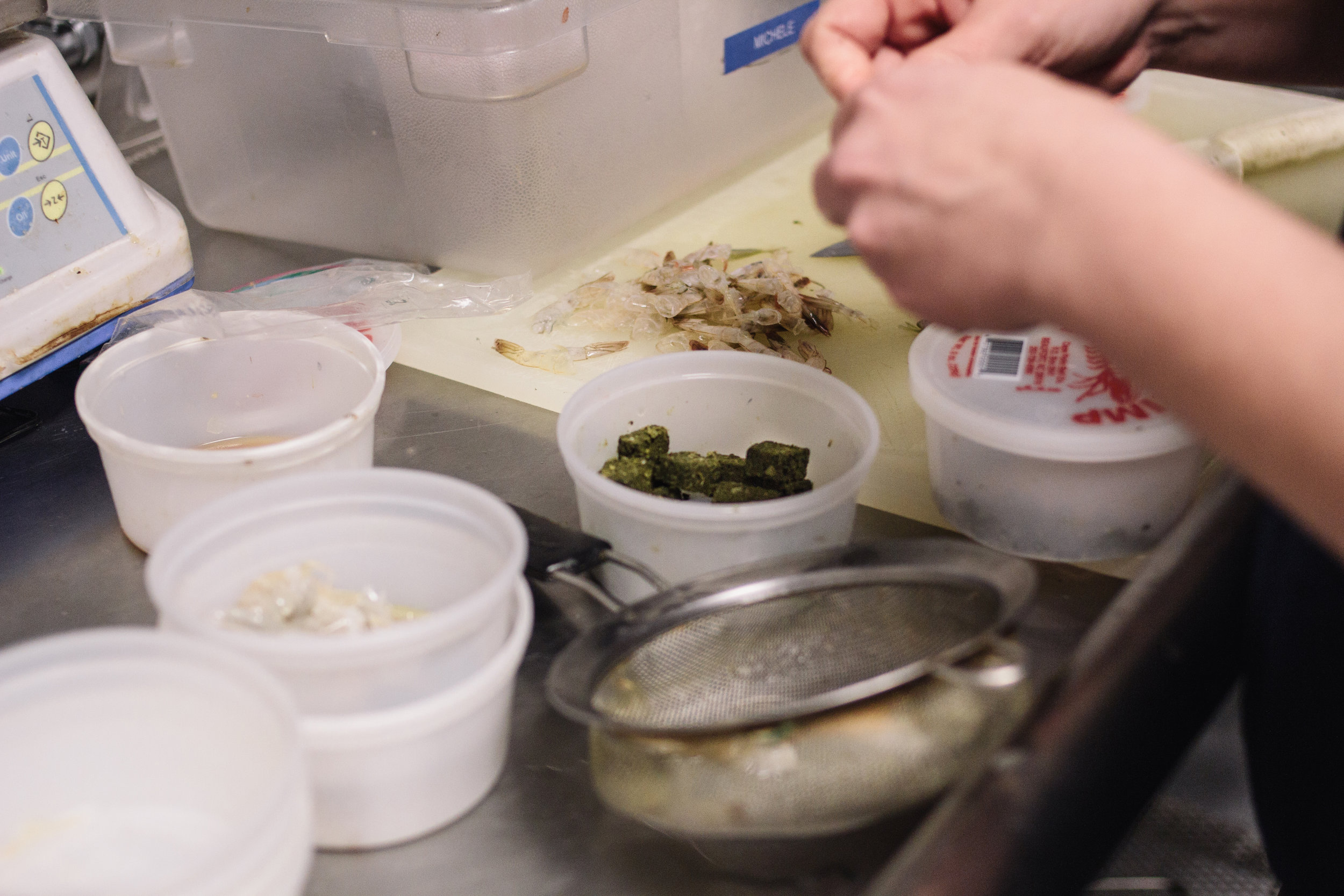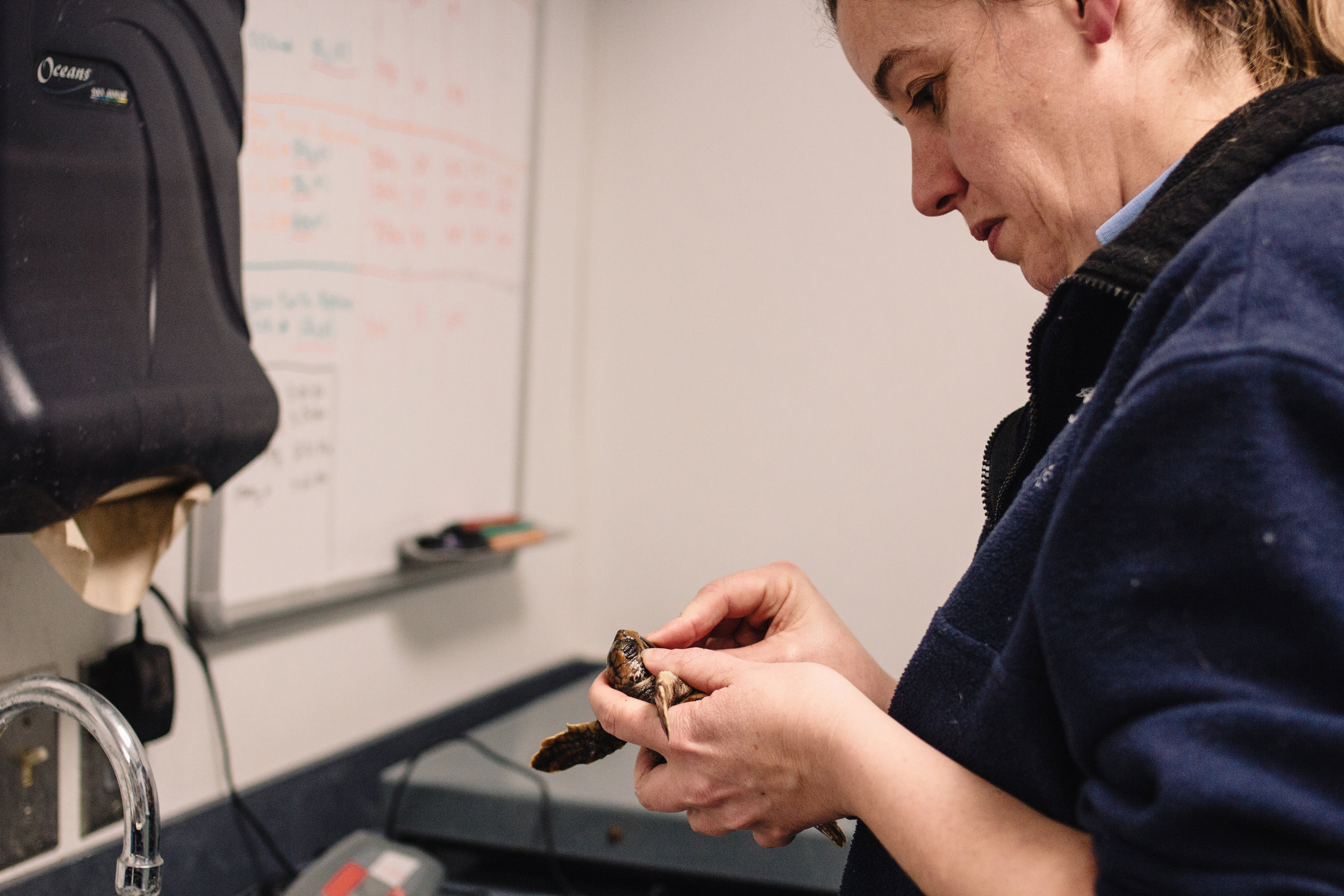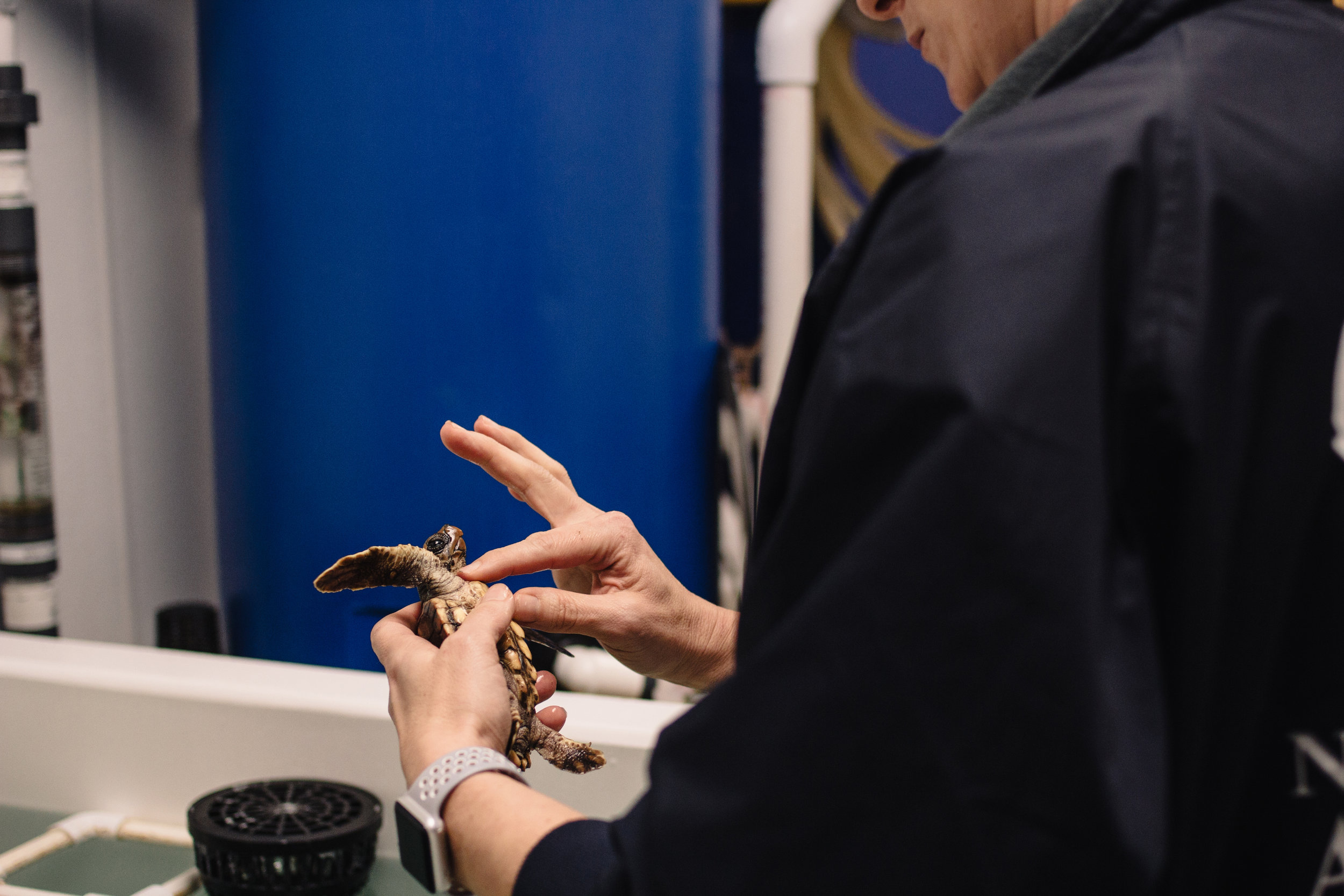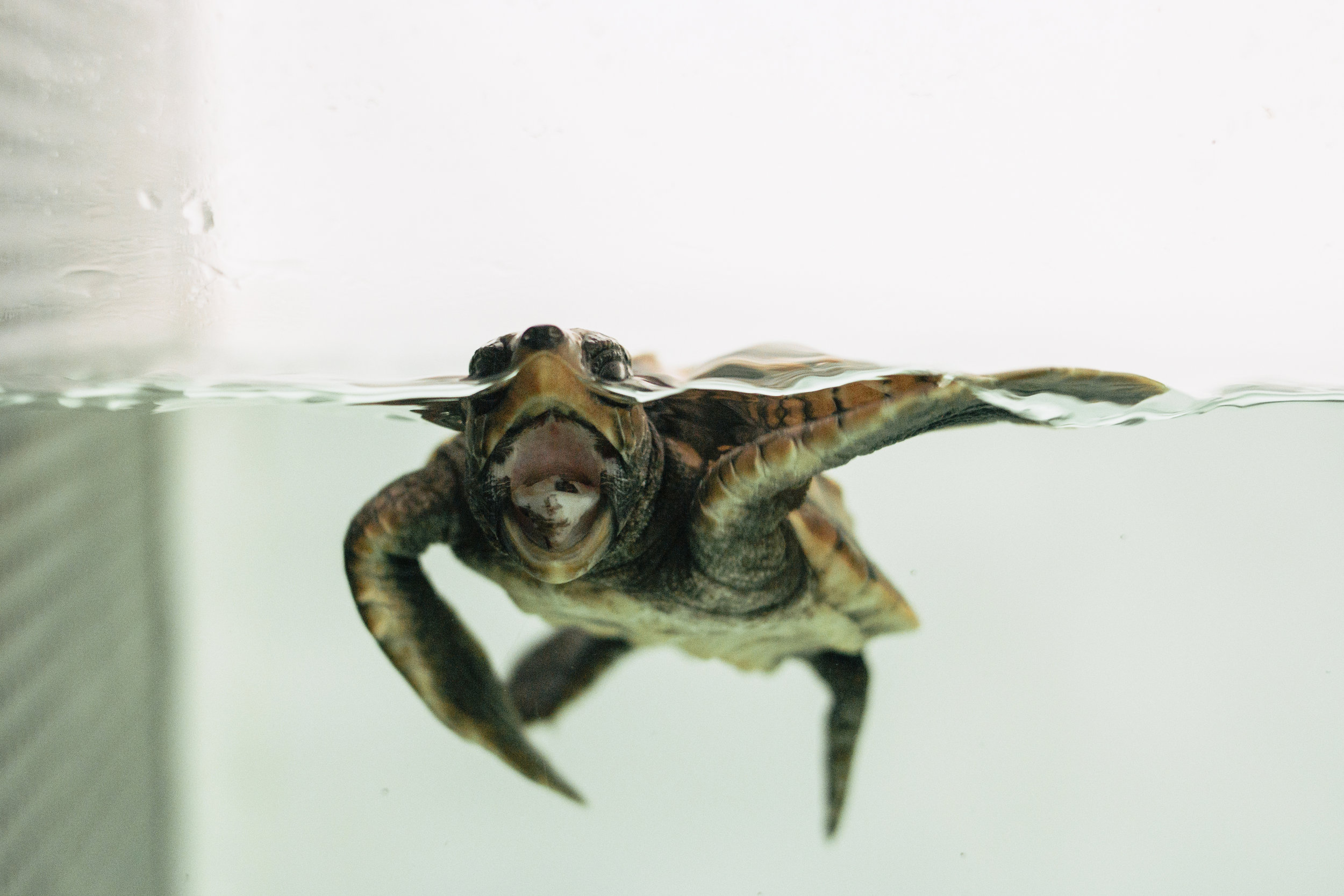Sea Turtle Rescue
Originally published in Carolina Shore. Words in italics are personal thoughts and information that simply couldn't make the article, but I thought you might enjoy. All photos are from my morning behind-the-scenes with the Pine Knoll Shores Aquarium.
It is just after midnight on our warm, quiet beach. Waves break the quiet of a coastline that is asleep, sweeping the activities of the day out with the tide. A being emerges out of the water, moving cautiously up the beach. She is many things: a skilled navigator, a huntress, a creature of some mystery and now a mother. She is also a sea turtle of the loggerhead variety, and she is looking for a safe place to create a nest and lay her eggs. Scooting her way up the sand, she selects a spot near the low dunes and digs a nest the width of her flippers, then scoops out a special chamber for the eggs with her back flipper. With all of the preparation finished, she lays between 100-120 eggs, which will be covered and remain buried beneath the sand for the next 50 to 60 days. Her work completed, the mother returns to the ocean. This ritual will be repeated several times within nesting season, which in North Carolina runs from May through September. After the turtle embryos have reached maturity, they become hatchlings, breaking out of their eggs with a tooth grown specifically to help them make their first journey. The hatchlings fight their way up and out of the sand, and (if all goes well) scramble out to the ocean. Once they hit the water, their instincts kick in and they soar through the ocean in the first surge to get them safely off the coast.
North Carolina has 330 miles of ocean-facing sandy beaches which can serve as turtle nesting grounds. Out of only seven species of sea turtle, we see four here in our state. Loggerheads are the most common species on our coast, followed by green turtles, with a rare sighting of Kemp’s ridleys and leatherbacks. All seven species of turtles are internationally listed as vulnerable for extinction, due to the challenges that face them at every age. As hatchlings, sea turtles are in danger from predators. On land, there are plenty of birds and crabs who would love to use them as a food source before they even make it out to the water, while predators also roam the ocean. This is a difficulty sea turtles have faced for thousands of years, and the sheer numbers of their reproduction (300-500 per female in one nesting season) show that they have adapted to cope with their place in the food chain. Where real trouble tends to come in is the human effect on turtles.
When a hatchling emerges from the sand, the first thing he will do is find the brightest horizon, and start working his way towards that. While this was a foolproof tactic in the days before electricity, now it has proved to be problematic. With lights blazing out from homes and businesses that sit directly on the beach, it is easy for the turtle to go the wrong direction up over the dunes and towards predators such as foxes, raccoons and fire ants. If the hatchling is fortunate enough to head out in the right direction, he is at risk of getting tangled up in trash or equipment left on the beach, or falling into a hole and being unable to flounder his way out of it. Risk of dehydration is high; if he does not make it to the ocean by about nine o’clock in the morning, the prognosis is not hopeful. The lucky turtles that make it out to sea tend to feed at the surface of the water, where plastic (which can look like a tantalizing meal) floats. After his first push off shore a small turtle is weak, so he is at the mercy of the environment and currents - currents which frequently carry trash with them. Even if a turtle isn’t immediately impacted by consuming plastic, it can sometimes cause secondary effects that make normal life processes more difficult, and make them more susceptible to dangers like cold stun, a reaction to long periods in cold water. With mild cases of cold stun, a turtle can snap back simply by moving to warmer water for the day. In severe cases they are motionless, at the mercy of the currents and passing predators. The lucky ones get washed ashore and reported to a team of people who are working to give sea turtles a fighting chance, from nest to open water.
The crew called in for any turtle incident is most likely going to be the Emerald Isle Sea Turtle Patrol. A nesting mother, wandering hatchling, stranded adult, or even a dead turtle - you name it, they can deal with it. As their program coordinator Dale Baquer told us, their chief responsibility is for nesting mothers and their hatchlings, but they know who to call for other situations and how to manage them. For sick or injured turtles of all ages, there are several options for rehabilitation: CMAST in Morehead City, the Karen Beasley Sea Turtle Rescue Center just north of Topsail, or the aquarium in Pine Knoll Shores. The turtles that are transported to the aquarium are under the careful eye of Michele Lamping, who heads up their turtle care with the assistance of their team of aquarists. Once turtles are back to fighting fit, the rehabilitation center coordinates with the North Carolina Wildlife Resources Commission for a release. Although the state only started monitoring turtle behavior in the 70s, their network has grown to over a thousand people in the intervening decades of observation, training, and care coordinating. For the Bogue Banks area, the first liaison is the Emerald Isle Sea Turtle Patrol.
The Sea Turtle Patrol is made up of around 250 volunteers, all working in specific capacities to help ensure turtle safety. They cover thirteen miles of beach, split into one mile zones. During nesting season, walkers in each zone are out at dawn to look for tracks left by nesting mothers and to clean up trash on the beach. When a nest is discovered, other members come out to stake it off (or to move it, but they only transport nests when it is absolutely necessary, preferring to keep things as natural as possible). Once a nest is close to hatching (known as a boil), nest sitters keep a vigil through the night to ensure that when the hatchlings make their appearance they make it out to the water. During the summer, the sitters often have plenty of company; visitors pull up their beach chairs and settle in to watch the nest and ask questions, this draws in more people, and before you know it, it’s a turtle party. The fall boils tend to be more quiet, intimate affairs with just the sitters and hatchlings.
A few days after a boil, the patrol excavates the nest and takes an inventory, which gets turned over to the NCWRC. Coordinator Dale Baquer and co-coordinator Ruthie Gomez-Stuart handle the logistics of keeping 250 people organized and up-to-date on regulations set forth by the Wildlife Commission. Along with direct interactions with the turtles, the next big goal of the Turtle Patrol is to expand public outreach and awareness. Baquer and Gomez-Stuart have begun reaching out to homeowners associations to talk about making light more turtle friendly, and are working on a website to make information easily accessible to the public. Despite strategy and organizing, turtles remain the first love of both Baquer and Gomez-Stuart, who both site interacting with them as why they got involved in the first place, and their favorite part of the job. There is a certain magic to sea turtles that just draws people in.
Such was the case for Michele Lamping, turtle care coordinator at the Pine Knoll Shores Aquarium. While interning and working with dolphins with Mote Marine in Florida, Lamping kept finding herself slipping into the lab before work to spend time with the injured sea turtles. After working at the Fort Fisher aquarium for some time, she came over to Pine Knoll Shores to help with the expansion and turtle program, and has been there ever since. One can see the years of experience as she goes about the day’s routines: cleaning the holdings where recovering turtles live, checking water, chopping and weighing out each turtle’s food down to the gram and navigating the maze of holdings back behind the exhibits in the aquarium, all almost mechanically. A matter-of-fact scientist, her voice softens when she talks towards her flippered charges. Despite the patterns of the everyday (clean, chop, feed, observe) the job is not boring; Lamping knows each turtle under her care, and is keeping a careful eye on their widely varying needs.
The makings of a turtle meal. Yum?
Turtles who have been brought in for cold stun have to be thawed out, raising the temperature of the water slowly and keeping its levels deep enough to prevent the turtles from dehydrating, but not so deep they drown. These turtles need different treatment than, say, a turtle with a broken fin (time, quiet and rest, plus a holding that will allow them to practice diving the first four feet from the surface) or a lethargic hatchling.
A little bit of turtle abstract.
Another aspect of turtle care for Lamping is being ready for whatever number of turtles the Wildlife Commission wants to send her way - in the height of nesting season, that can be anywhere from ten to one hundred in one day. The challenge of designing and building all of the life support systems is one that Lamping enjoys. All of the systems have to meet certain requirements for the health of the turtles, but they also have to be sturdy, waterproof, and completely adjustable for individual turtle’s needs. When the aquarium is at maximum turtle capacity, the holdings are anywhere and everywhere. Wherever they fit, there are holdings filling the cement and fluorescent jungle, tucked behind exhibits and in front of offices. A turtle holding in the rehabilitation section is kept intentionally minimal.
Since turtles are skittish animals, new things unsettle them - so they are kept in small, separate areas to encourage rest and sleep, in clean surroundings with one semicircle to shelter under, rest on or rub against. Every two weeks the patients receive a visit from the vet who either designates them ready for release, or gives an updated list of requirements to Lamping. The turtles who are returned to the wild have their instincts kick back in immediately - even the ones who required a year or two with the aquarium to get them to full health.
“Really, all’s we’re doing is for that part is countering human activity,” Lamping explained. “If it wasn’t for human activity, there’d be no need for us, because the sea turtles know what they’re doing.”
During feeding time, Michele was keeping a wary eye on this one turtle.
"If there's any one that will give us trouble, it's this guy," she said, kneeling by his holding and waiting to see him actually swallow his food. Sure enough, a small bit of something got caught on the way down. After plucking him out of the water and trying to manage it herself, she ended up needing to call in more hands. Once the situation was taken care of, the turtle was returned safely to his holding, where he followed the exact behavior patterns Michele predicted. This woman knows her turtles.
What human activity is harmful to turtles, and what are some easy-to-implement changes you can put into place to give turtles a better shot? For starters, you can practice basic beach etiquette: once your day in the sun and sand is done, make sure you take home any equipment you brought and dispose of any trash (as Gomez-Stuart pointed out, burying it doesn’t count - it needs to be up and away from the beach). In addition to deterring nesting sea turtles, deep holes in the sand can be troublesome to emergency vehicles and to hatchlings struggling to get to the ocean - so before heading inside, try to fill in any craters created by sand castle competitions or man-made tide pools. Once you’re inside and things are shutting down for the night, turn off any lights that can be seen down on the beach. Extraneous lights can spook nesting mama turtles, and confuse hatchlings. Even after your trip to the beach ends (how is it that time by the ocean is always one day too short?), there are still things you can do. Garbage - particularly plastic - that looks like food is a big problem for turtles. If you can trim back your plastic usage at home, that reduces the risk of your waste making it to the sea. You know those cloth bags people take shopping? It might be time to cave and get some. Storing them in the trunk of your car makes it so you don’t even have to go to the trouble of remembering them when you’re headed out to shop. Another easy step is to stop using plastic straws. Americans use 500 million straws each day. Straws are among the top ten items found during beach cleanup, in a place where 60%-80% of marine debris is made up of plastic, according to the EPA. There are two simple remedies for this: either stop using straws altogether, or find a paper replacement.
Maybe these things are already a part of your life, and you would like to get directly involved with our flippered friends. If you have a flexible schedule, the Emerald Isle Turtle Patrol would be a good place to start - all volunteers begin as walkers, scouring the beach starting at six every morning. Volunteer opportunities also abound with the Karen Beasley Sea Turtle Rescue Center and the aquarium, if your skills are tilted more towards ongoing care or education. If you see a turtle struggling while you are out on the beach, the best thing you can do for it is to stand back and call in the people who have been trained to handle him (see phone numbers at the end of the article). Touching a turtle can cause an exchange of bacteria which is at best unhelpful and at worst fatal, and picking him up could exacerbate the problem that caused him to strand in the first place. Until you are properly trained, call in the people who are passionate and trained for turtle care.
Whoever you are and whatever you do, there are changes that you can make to help insure our oceans have a future with a surviving sea turtle population. Another fifty years of progress, and we might even begin to hope for a thriving community of sea turtles - but for now, it’s a matter of working them off the endangered list. Taking animals from endangered to a healthy population is not pie-in-the-sky idealism, it is something that has already been done in the US with well-known species such as the American alligator, bald eagles, the grizzly bear and the American gray wolf. Sea turtles contribute to our lives as members of the ecosystem - besides their obvious cuteness adding to our lives in the joy department, they help keep the water clean, and keep sediment at the bottom of the ocean properly balanced. Sea turtles even add to our economic scene - green turtles foster seagrass beds which serve as nurseries for fish that are favored among commercial fishermen, not to mention the tourism pull of vibrant wildlife in a state where tourism is the third biggest source of income. Whatever you motivations, and whatever level of effort you can manage, sea turtles will prove themselves to be worthwhile.
If you live in Emerald Isle and see a turtle in need of assistance, give it space and call either: Dale Baquer of the E.I. Turtle Patrol (252-646-8292) Or: The non-emergency police number 252-354-2021 (don’t call 911, that is reserved for human emergencies).
If you’re walking the beach and see a turtle nest with a sitter, stop and talk to the sitter! The people on the sea turtle patrol are passionate, friendly people who would love to answer your questions and tell you more about these creatures. I talked to one just recently, and in addition to watching the most beautiful night sky I’ve ever seen (we could see Mars AND the Milky Way!), she gave me a lead for my next story.




